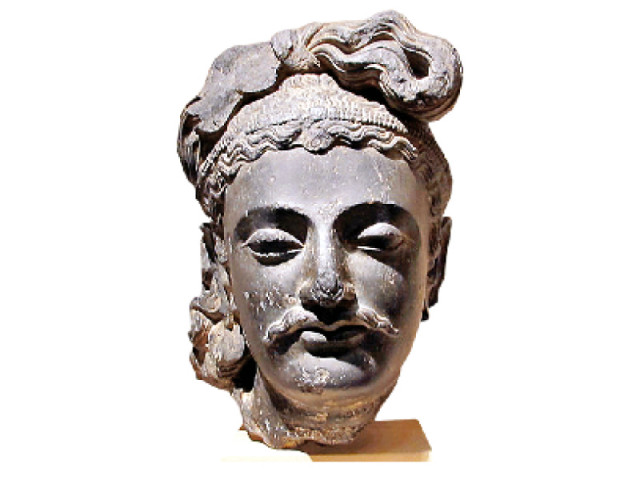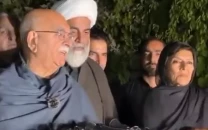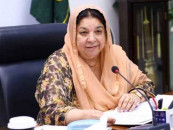Days gone by: K-P continues to be deprived of its Gandharan glory
v excavated from the region remain in possession of museums elsewhere in the country.

Due to the absence of a museum in the region, all artefacts discovered from the Peshawar Valley in the British era were transported to the nearest museum in Lahore. PHOTO COURTESY: WIKIMEDIA COMMONS
Originating from an area that was once known as the ‘centre of education’ in the world and a pinnacle of Buddhist culture, priceless Gandhara antiquities and sculptures from across Khyber-Pakhtunkhwa (K-P) remain in possession of museums in other parts of the country.
A source at the K-P Directorate of Archaeology and Museums, requesting anonymity, said there were a large number of unspecified artefacts with various museums across Pakistan, in particular at Taxila Museum, Punjab. He added that these artefacts were in so high a number that the department had no exact records of them.
“This cache was in the possession of the federal department of archaeology’s sub-regional office (SRO),” he said, “After the 18th Amendment, this department was devolved to the province; however, the artefacts remain at the museum.”
Another source familiar with the matter corroborated that these antiquities were stored at the museums in Islamabad and Taxila. However, he added that it was difficult to determine their exact places of origin. He said the SRO’s material had been collected from various parts of the country and the material would now have to be sifted through.

Another museum that is teeming with artefacts from Gandhara is the Lahore Museum. Explaining how these pieces were ‘loaned’ out and never returned, an insider said a majority of the antiquities were shifted there by the British before the creation of Pakistan.
“There was no museum in this region, where the earliest excavation of Gandhara sites was started by the British,” he said. “Almost all of the artefacts had to be shifted to the nearest museum, which was in Lahore.”
Tallying the numbers
A list compiled by the K-P Directorate of Archaeology and Museums, available with The Express Tribune, shows that the National Museum of Pakistan, Karachi alone has about 6,824 such pieces from K-P in its possession.
The breakdown shows that the National Museum in Karachi has 1,118 artefacts in its custody, along with another 5,706 ‘confiscated items’. Similarly, the Exploration and Excavation Branch Karachi has 206, Taxila Museum has 1,666 and Islamabad Museum has about 158 artefacts.
The list puts just the total documented number of K-P’s antiquities in possession of museums across Pakistan at 8,854. The actual figure of the lost remnants is said to be much higher.
Taking (no) action
Earlier, there were reports that under the former director, K-P’s provincial archaeology directorate has approached the aforementioned museums to reclaim their property. Despite repeated attempts and claims, though, K-P’s archaeological heritage remains in the line of dispute.

The provincial government, in the past, has referred the issue to UNESCO, stating that it is a universally accepted principle that archaeological material recovered from ancient sites located in a particular region is the property of that region and should be returned there.
The federal and provincial governments have also been reminded multiple times that the geographical boundaries of Gandhara were limited to present-day K-P, except for Taxila. Resultantly, they claim that Punjab and Sindh have no cultural, historical or legal right to artefacts from Gandhara.
However, K-P Archaeology Director Professor Dr Nasim Khan, claimed they were preparing a comprehensive list of these artefacts and that he was not aware of any such steps taken in the past.
The chairman of the Department of Archaeology at Hazara University Dr Abdul Samad, on the other hand, opposes any idea of reclaiming the antiquities, terming cultural heritage as ‘universal property’ and saying that the whole world has a right to it.
“Go to Peshawar Museum and see for yourself what conditions these remnants of history are in,” said Samad, adding that he opposed the return of the pieces on the same grounds, since K-P had no capacity to take care of heritage assets.
Dr Samad went on to propose that K-P should divide its archaeological reserves with other museums of the country, so that these items do not deteriorate in storage. He claimed the Gandhara pieces at Lahore attract a large crowd and are more appreciated there than they are at their place of origin. The professor proposed a barter system, saying that Peshawar Museum should take pieces from Moen jo Daro, and vice versa, adding that such steps will lead to greater cross-cultural understanding.
Published in The Express Tribune, April 6th, 2014.



















COMMENTS
Comments are moderated and generally will be posted if they are on-topic and not abusive.
For more information, please see our Comments FAQ